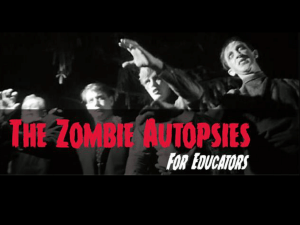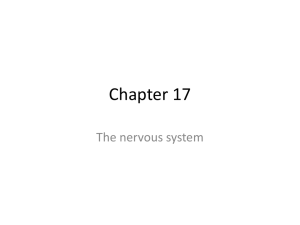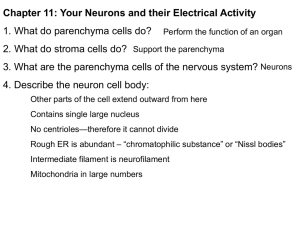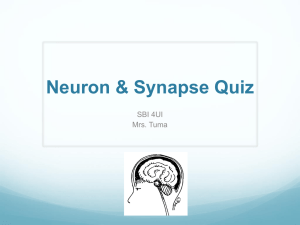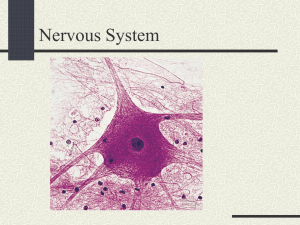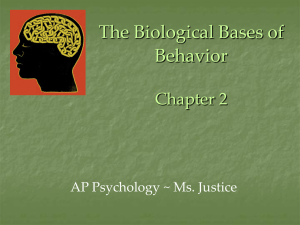Ap Psych Brain Powerpoint
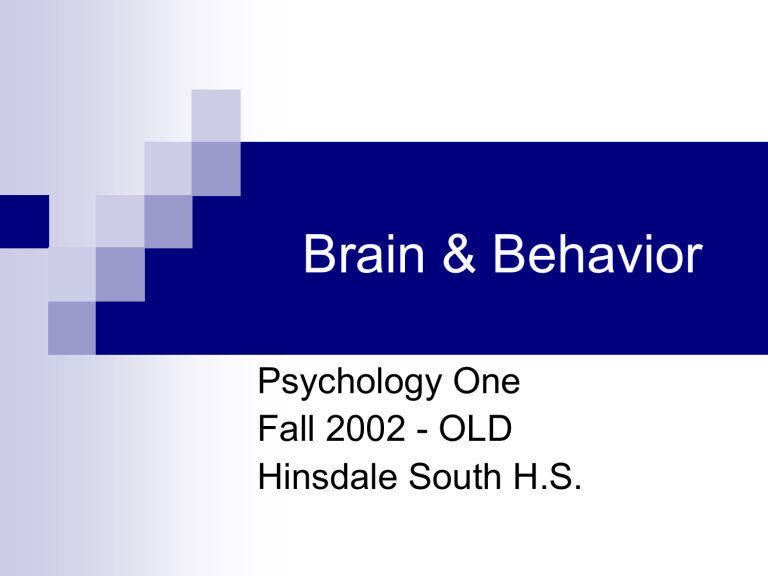
Brain & Behavior
Psychology One
Fall 2002 - OLD
Hinsdale South H.S.
ANNOUNCEMENTS
- Keep reading Unit III on Brain pg 94-110
- The entire outline through 121
- Outline Due MONDAY
- TEST MAKEUPS BY MONDAY!
WHY STUDY THE BRAIN IN
PSYCHOLOGY?
WHAT HAPPENS TO CUTLER’S BRAIN
WHEN HE IS SACKED?
Fact:
Men’s brains are not fully developed until age 22 while girls develop sooner. Why?
See packet (Men’s vs. Women’s Brains)
Figure 2.7 The functional divisions of the human nervous system
Myers: Psychology, Eighth Edition
Copyright © 2007 by Worth Publishers
Single Neuron
(see packet for diagram)
1. Dendrites
2. Cell Body (Soma)
3. Nucleus
4. Axon
5. Glial Cells
6. Nodes of Ranvier
7. Covering = Myelin
Sheath
8. Terminal (Axon) Buttons
9. Terminal Branch
The Neuron
What is it?
Cells of nerve tissues where messages travel to and from the brain
Where are they found?
Everywhere in your body! You have millions of them!
What type of communication happens here?
Electrical Action Potential
Chemical
Axon
Parts of the Neuron
Nodes of Ranvier
Myelin Sheath
Terminal Branch
Dendrites
Cell Body Nucleus Axon
Terminals or
Terminal
Buttons
Synapse
Neuron Parts
Nucleus -
Brain (converts chemical messages to electrical messages)
Cell Body -
Houses the nucleus, vesicles that carry neurotransmitters to the axon terminal are produced here.
Myelin Sheath -
Fatty, insulation, which protects the axon and speeds impulses (Glial Cells help repair)
Nodes of Ranvier –
Breaks in the meylin sheath where depolarization occurs;
Neuron Parts
A xon –
Fibers that carries electrical impulses A way from the cell body.
Electrical impulses travel down the axon as depolarization happens at each Nodes of Ranvier. Depolarization happens multiple times along the axon.
As the action potential moves, vesicles are carried closer to the axon terminal.
Dend r ites –
Fibers that r eceive neurotransmitters (chemical communicators) from other neurons
At the cell body, the chemical message is downloaded and is translated into an electrical impulse which then travels down the axon.
Receive messages like a Post Office
Neuron Hand Model
Fingers = Dendrites
Palm = Cell Body
Dot = Nucleus
Arm = Axon
Skin = Myelin Sheath
Elbow = Terminal Button
ALONG THE AXON:
Action Potential – A brief electrical charge that travels down the axon like a domino effect, one triggers the next.
Happens very quickly.
Resting Potential – When the axon is waiting to be fired. Sodium on outside and
Potassium on the inside. (SALTY
BANANA)
ALONG THE AXON
Depolarization-
As the AP moves down the axon, this is the process of the positively charged sodium particles to move inside the axon and the negatively charged potassium particles move outside the axon. This occurs at the nodes of ranvier.
Refractory Period-
After depolarization or the firing of an action potential, the sodium returns to the outside of the axon and the potassium returns to the inside .
Depolarization
Figure 2.3 Action potential
Myers: Psychology, Eighth Edition
Copyright © 2007 by Worth Publishers
The Synapse
Definition:
The space between the axon terminal and the next dendrite.
Sends chemical messages called, neurotransmitters, to the next neuron.
Vesicles are balloon
Neurotransmitter like structures that carry neurotransmitters
Docking
Site to the synaptic gap.
Action
Potential
Axon Terminal
Vesicles
Synapse
Dendrite
Things to Remember About a Neuron Firing!
1. All or none response – a neuron either fires or does not. There is no partial firing.
2. Threshold – to get a neuron to fire, there is a threshold of neurotransmitters that must be met in order for a neuron to fire.
3. Lock and Key – There are certain receptor sites for specific neurotransmitters.
Figure 2.4 How neurons communicate
Myers: Psychology, Eighth Edition
Copyright © 2007 by Worth Publishers
A. Axon B. Dendrites C. Neurotransmitters D. Sodium ions
B.
E. Terminal branches
Chemical messengers called neurotransmitters enter receptor sites on the dendrites and cell body. This causes the cell membrane to open up and sodium ions to flow in. When there is enough of a positive charge, the neuron reaches threshold, and the first section of the axon opens up and sodium ions flow in. This exchange of sodium ions happens down the length of the axon . When the signal reaches the terminal branches at the end of the axon, neurotransmitters flow out into the empty space called the synapse.
Why do we not have one big neuron running through out our body?
Can we slow and speed up our impulses? Give an example.
Will your leg or arm itch first and why?
Basic Reflex -
SIM
1.
2.
3.
4.
5.
Touch something hot
Skin receptors pick it up, sends it to sensory neuron that carries it to the spinal cord
The interneuron in the spinal cord translates it into an action.
Motor neuron carries message to finger to move it away from the flame.
DOES NOT GO TO BRAIN FIRST!!
Figure 2.9 A simple reflex
Myers: Psychology, Eighth Edition
Copyright © 2007 by Worth Publishers
FACTORS that effect Neurotransmitters
AGONISTS – mimics a neurotransmitter or stops reuptake
ANTAGONISTS – speeds up reuptake or stops production of neurotransmitter.
Excitatory – (speeds up or continues communication) agonist
Inhibitory – (slows down or stops, antagonist
Table 2.1
Myers: Psychology, Eighth Edition
Copyright © 2007 by Worth Publishers
Announcements / Review
Review!
What is the difference between agonist and antagonist?
Neurotransmitters associated with Schizophrenia,
Alzheimers, Depression?
REUPTAKE, Depolarization, Neuron Parts
Thalamus, Sensory Cortex, Left hemisphere
Phineas Gage?
Huntington’s Disease?
Broca’s and Wernicke’s Areas
General Region of Parts
QUIZ THURS ON NEURON AND BRAIN
EC? BRAIN DAMAGE GAME THURS!
What is the outer most part of the brain called? There are three names for it!
The Brain
The lobes are specific areas contained with in what
Lobes of the Brain
part?
Primary Somatosensory
Occipital Lobe –
(visual cortex
Parietal
Cortex located within) Primary Motor
Cortex
Vision
Occipital
Parietal Lobe –
Body Sensations
Frontal Lobe –
Working memory,
Personality
Temporal Lobe –
(auditory cortex located within)
Frontal
Hearing Temporal
Sensory and Motor Corex
Sensory Cortex – is located in the
Parietal Lobe , controls body sensations such as temperature, pressure and pain.
Motor Cortex – is located in the
Frontal Lobe , Top controls your toes, bottom controls your head. Facial movement control takes up a lot of motor cortex.
Parts of the Brain
Cerebellum-
Posture & Balance &
Coordination of Thinking
Cerebral Cortex –
Contains 4 lobes, aka forebrain & cerebrum
Corpus Callosum –
Divides 2 hemispheres
Pituitary Gland
Master gland of endocrine system
Corpus Callosum
Cerebellum
Hindbrain
Forebrain
Cerebral
Cortex
Thalamus
Hypothalamus
Pituitary
Gland
Spinal
Cord
Midbrain
What part of the brain would this rat’s car be hooked up to?
While this contraption looks similar to a doggy wheelchair or a pair of prosthetic legs for your favorite pet, it’s actually much more sophisticated.
This rat is hooked up to a prototype of a thoughtguided robot wheelchair .
http://blogs.discovermagazine.com/ discoblog/2010/10/05/its-a-ratits-a-toy-car-its-ratcar/
Hemispheres of the Brain
Left
Verbal: speaking, understanding language, reading, writing
Mathematical
Analytical: analyzing separate pieces that make up a whole
Right
Nonverbal: simple sentences & words
Spatial: art, geometry, facial recognition
Holistic: combining parts that make up a whole
Other Areas Within LOBES
Angular Gyrus – In the parietal lobe, i nvolved in a number of processes related to language, mathematics and cognition.
Gyrus – Ridges in the brain, more surface area for memory storage.
Broca’s Area – Left, Frontal Lobe ,
Production of Speech
Wernicke’s Area – Left, Temporal Lobe ,
Comprehension of Speech
The Endocrine System - Hormones
Pituitary Gland – Master
Gland, HGH
Thyroid – Metabolism
Adrenal gland –
Adrenaline /
Noradrenaline
(epinephrine and norepinephrine)
Pancreas – Insulin
Testes – Testosterone
Ovaries – Progesterone and Estrogen
LIMBIC SYSTEM
– controls emotions, contains four parts (midbrain), connected to frontal lobe! (PHINEAS GAGE)
Thalamus The brain’s sensory switchboard, located on top of the brainstem or midbrain
Hypothalamus - Controls maintenance activities like drinking, eating, sexual arousal. (midbrain)
Amygdala = anger and fear (mid brain)
Hippocampus = memory creation (mid brain)
HINDBRAIN / BRAIN STEM
Old brain, most animals have this portion
Medulla – helps circulate spinal fluid, regulates autonomic functions.
Pons – respiratory functions.
Reticular formation – arousal.
Cerebellum – posture, movement and coordination of thinking.
Disorders of the Brain:
Prosapagnosia = facial blindness
Aphasia = interference with speech, what 2 parts?
Blind Sight = failure to consciously see change but can subconsciously notice visual change.
Huntington’s Disease = decay of brain, late onset
Synestheisa = Crossing of Senses – See Colors for
Sounds you hear. Taste Words.
THINGS THAT HELP OUR BRAIN:
Plasticity – Rewiring the brain after an injury
Neural Networks – More synaptic connections = Better Memory
Long Term Potentiation – Memory =
Quicker and more efficient neural firing.
WAYS TO STUDY THE BRAIN
Lesions – tiny areas of destruction
EEG – measures electrical signals / waves
CT – takes slice images of object
MRI – helps look at soft and hard surfaces like X-ray
PET – radioactive injection, brain glows with active parts (red active, blue not active)
LOBOTOMY
Which gives the best view of the brain?
Who is Phineas Gage?
Rail Road Worker
Accident
Survived!
Showed us the amazing capabilities of the brain!
See AP Edition Review Brain PPT
For practice questions
Practice Questions….
You are a pathologist in a large Northwestern city. You are conducting an autopsy on an
83-year-old male who was found dead in his home with no obvious cause of death. During the autopsy you discover the individual suffered two strokes. Based on the functional information below provided by the next-of-kin, where were the two areas that suffered from the cerebral vascular accidents?
failure to do certain specific movements massive overeating disrupted circadian rhythms increased susceptibility to stress poor muscle tone discontinued secretion of gluccocorticoids inability to adjust heart rate unrestricted water loss in kidneys loss of control to react to body temperature changes failure of the respiratory system inability to do locomotion
Practice Questions…..
At 1:30 am you (a trauma surgeon) are called for emergency surgery on a 17 year old
Caucasian female that was shot in the head during a drive-by shooting. After a tedious surgery, the patient remarkably remains alive and doing reasonably well. The bullet traveled completely through the skull leaving a path of destroyed tissue behind it. You have decided to speak with the parents about what noticeable changes will occur in their daughter due to the destruction of neural tissue. Based on the information below, determine the approximate path the bullet traveled (i.e., what structures were damaged – keep in mind that it is possible for fragmenting and ricocheting of the bullet resulting in somewhat unlikely combinations of areas effected).
limb apraxia inability to control the muscular movements of the left shoulder, arm, forearm, and hand slow, laborious, nonfluent speech inability to sound out words and write them phonetically pure alexia difficulty finding appropriate words when speaking inability to use or recall nouns in speech and communication inability for sensory input to be recognized verbally poor word repetition decreased sex drive
Practice Questions…….
Mr. Livingston is a 39 year-old African-American male who has been brought into your neurology clinic by his wife. She has become increasingly alarmed regarding her husband’s health over the past four months. Upon completion of a
CT scan, it is determined that Mr. Livingston’s condition is the result of the presence of two tumors that have developed within his brain. Using the patient history information listed below and the information from class and your textbook, determine where these two tumors are probably located.
muscle weakness vastly increased appetite (gained 25 lbs in the last three months) inappropriate body temperature fluctuations jerky movements decreased sexual desire poor balance when walking and standing increased frequency of urination inability to throw objects inappropriate sleep patterns (seems to fall asleep randomly during day and night) uncontrolled aggressiveness (rather violent, “short fuse”) exaggerated efforts to coordinate movements in a task
Practice Questions Answers
Exercise 1: The two tumors are located in the hypothalamus and the cerebellum.
Exercise 2: The damaged structures include: the right (primary motor cortex), the corpus callosum, Broca’s Area (left frontal lobe), and the left temporal gyrus.
Exercise 3: The stroke regions were the hypothalamus and the reticular formation.
Portable Brain Model
Limbic System –
Emotions, personality
Fight or Flight Response
Cerebellum –
Body movement
Spinal Cord –
Receives & sends messages
Cerebral Cortex –
Left & Right Hemispheres
Neuron Demonstrations
Be sure to take notes on these to better your understanding!
Hershey Kiss Student Axon
Neurotransmitters are represented by kisses.
Dark Kisses = Inhibitory
Signal = Slow Down
Red Kisses = Excitatory
Signal = Speed Up
Spray of water = release of neurotransmitters from vessicles.

